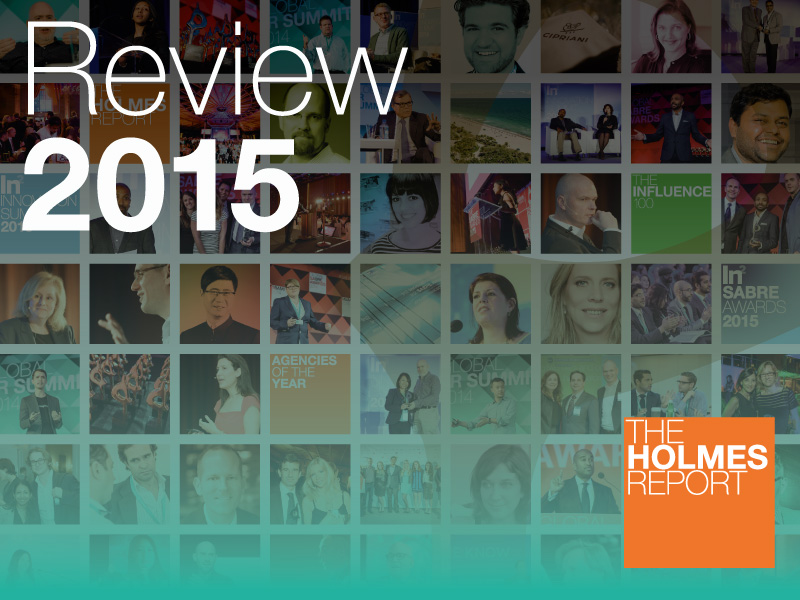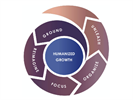Paul Holmes 20 Dec 2015 // 4:33PM GMT

For an industry expanding in size and sophistication, public relations continues to lack the underpinning of a formal body of knowledge, and the kind of social science research that could inform strategy and messaging and creativity. So at the end of the year, it’s worth taking a moment to acknowledge and celebrate studies that add an empirical element to our understanding of how to manage the function and maximize its business impact.
This year, The Holmes Report covered a wide range of original research and provocative thought leadership, ranging from the alarming (PR is dead?) to the encouraging (advertisers and marketers think we should be leading social). Here are 12 of the best from the past 12 months:
1. Is “Earned Influence” the New Black
Chris Graves, in his dual roles as leader of Ogilvy Public Relations Worldwide and the PR Council, spent more time thinking about the “big picture” issues facing the industry than most of his peers—who find the quotidian reality of running the day-to-day business sufficiently challenging—and so it’s no surprise that he spearheaded this effort to emphasize “earned influence” rather than “earned media” as the core competence of our profession. Embracing public relations (as opposed to narrower terms like communications), Graves argued that “at our essence, we understand the art and science of building relationships. When successful, those relationships allow us to engage others with purpose and respect, to share, educate, inform and entertain. Through these relationships, we earn the right to try to join conversations and maybe even change minds. We earn that right to influence others.”
2. PR Should Lead Social
I’m a sucker for surveys showing that others recognize what should be obvious to PR professionals—that public relations should take the lead role in social media. So this survey from The Creative Group found that more than half (51 percent) of advertising and marketing executives said PR executives are best suited to oversee an organization's social media efforts, compared to 28 percent who thought marketing should lead and 9 percent who thought social media was a customer service function. No mention, sadly, of the fact that customer service should, in fact, be led by public relations people. Maybe next year.
3. Compensation Drives Culture, Culture Drives Strategy
Our Global Public Relations Summit has become a venue where industry players unveil a lot of new knowledge, and the annual Davis & Gilbert survey—which informs our Independent PR Firm Forum—generates the strongest buzz. The firm found that high-performing firms—with growth last year of more than 20 percent—were significantly more likely to have moved away from discretionary cash bonus and to offer either a structured bonus based on objective criteria or a long-term incentive plan—or both. Says D&G’s Brad Schwartzberg, “What we have found very successful is well-designed long-term incentive plans that both drives the kind of behavior and outcome that you’re looking for and makes it very difficult for competitors to lure your people away.” Yet relatively few firms have such plans in place.
4. Take the Blame, Move On
So there’s an element of “who’d have thunk it” to the finding that companies benefit when they accept blame for poor performance, and suffer then they try to deflect. On the other hand, so many companies continue to look for scapegoats (“Obamacare made me do it”) so maybe it’s helpful to have the kind of empirical evidence the University of Missouri provides. “Honesty is appreciated, especially when it’s a difficult message from leaders,” said Stephen Ferris, professor and senior associate dean at the MU Trulaske College of Business. “Investors will accept a forthright recognition of an honest mistake, expecting that corrective actions are likely to follow. When firms explain a negative event as due to an external cause, company leaders can appear powerless or dishonest to shareholders.”
5. PR World Report: PR Professional of the Future
Once again, our PR World Report—now part of our PRISM (Public Relations Industry Survey & Metrics) project—found that attracting and retaining talent is the biggest challenge facing public relations agencies. But this year, we dug a little deeper, trying to understand the kind of professionals agency principals are looking for to drive the business forward. The answer—perhaps not surprisingly—is that community management, insight and planning, and multimedia content creation are at the top of the list, with more traditional expertise (media relations, CSR, and even crisis expertise) in much less demand.
6. At the Same Time, Generalists Are Still Needed
Perhaps this focus on new specialists seems like a rebuttal of Arun Sudhaman’s argument, a month earlier, that PR needs more generalists—but we prefer to think of it as a companion piece. The rise of new disciplines demanding non-traditional skills does not obviate the need for well-rounded professionals who can pull disparate threads together and see the big picture. The crux of the argument: “Clearly, specialists are of critical importance; these days you would be hard-pressed to find a good PR agency that doesn't have access to content marketers, web designers, app builders, data analysts, video producers, media experts and more… But having those specialisms is one thing. Selling them, and understanding how to deploy them effectively, is another altogether, and it is here where the oft-maligned PR agency generalist has demonstrated an enduring capacity for reinvention.” The good ones are “set to become even more pivotal.”
7. The PR Industry’s Leadership Gap
There is a dramatic gap between the way PR industry leaders evaluate their own performance and the way their employees view that performance, according to the first Plank Center Report Card on communication leadership, based on a survey of 838 US public relations executives and managers, most of them in in-house roles. Leaders gave themselves an “A-” while followers gave their leaders a “C+” with the biggest gap coming in areas such as vision, relationship-building skills, and team leadership capabilities. “This gap doesn’t necessarily mean that leaders are ineffective,” says Bruce Berger, research director. “But closing the gap is nevertheless important because leaders influence all other issues in our study.”
8. Nobody Knows How to Measure Reputation Risk
I don’t know whether it’s encouraging (more people are taking an interest in what we do) or worrying (why aren’t we doing this ourselves”) but a lot of the best research on public relations comes from organizations outside the industry. Like the Reputation Resilience Report from law firm Schillings, which found that only 8 percent of FTSE 100 companies currently measure reputation risk, and only 23 percent of FTSE 100 companies say that reputation is “owned” by the board. According to David Imison, director of risk consulting at Schillings, “Analysts and investors know only too well that reputation is no longer an issue that can be kicked into the long grass in the good times; it requires constant attention…. The bigger you are the less of an excuse you have for not having the processes in place to deal with a reputational issue.”
9. CEOs Are Critical To Corporate Reputation
Of course, most of the top tier global PR agencies have a piece (or several) of signature research, adding significantly to the body of knowledge. Weber Shandwick’s CEO Reputation Premium study—based on an online survey of more than 1,700 senior executives across 19 countries—was among the most interesting last year, finding that CEO engagement and visibility is critical to company reputation, according to 81 percent of respondents, and that those same executives attribute nearly half (45 percent) of their company’s reputation to the reputation of their CEO. “Years ago, CEOs and those around them confused CEO visibility with CEO celebrity,” says Leslie Gaines-Ross, Weber Shandwick’s chief reputation strategist. “Today, it is not about CEO celebrity, but CEO credibility that can be built through multiple channels that add value inside and outside the organization…. Humility is now the new green among chief executives. Executives with highly-regarded CEOs are nearly six times as likely as those with less highly-regarded CEOs to say that their CEO is humble (34 percent vs. 6 percent, respectively).”
10. Trust Me, PR Is Dead
Back in January, Arun Sudhaman looked past the deliberately provocative title (a subtle dig at one of the industry’s most prominent pieces of thought leadership) to conclude that Robert Phillips’ book was “not so much an assault on the PR industry as a prescription for its ills.” While some thought Phillips set up an outdated straw man version of the industry to argue against, he made some important points about the shortcomings of the traditional agency model, and raised some questions about the ability of the biggest agencies to change quickly enough. According to Arun’s review: “Overlook the whiff of bitterness towards the agency world, and you will find a book that makes a strong and credible argument for a more sustainable compact between business, government and society. “
11. CSR Matters More to Millennials
The last two spots on this list are reserved for two long-running surveys that have—because of the ongoing commitment of their creators—established themselves as the most widely-quoted thought leadership pieces, both inside the industry and beyond. The Cone Communications research into cause branding CSR is now in its 22nd year and this year focused on millennials, whose expectations of corporate responsibility are higher and subtly different. More than nine-in-10 Millennials say they would switch brands to one associated with a cause (91 percent vs. 85 percent US average) and two-thirds say they use social media to engage around CSR (66 percent vs. 53 percent US average). And they want more communication from companies too, particularly via social media.
12. Trust, Evaporating
Edelman's 2015 Trust Barometer—the 15th in the long-running series—revealed a startling decline in trust levels across all institutions, with business suffering profound repercussions from a lack of genuine engagement. The study polled 27,000 general population respondents with an oversample of 6,000 informed publics aged 25-64 across 27 countries, continues to generate a ton of media coverage, and provide the agency with a platform for its presence in Davos. Meanwhile, the surprising finding that a majority of respondents believe innovation is happening too quickly (51 percent) and that it is driven by greed (67 percent) rather than consumer benefit, formed the basis of an interesting presentation in Cannes. According to Richard Edelman, "there must be a new compact between company and individual, where companies demonstrate that innovations are safe based on independent research, provide both societal and personal benefit and are transparent about the use of customer data."


































.jpg)



.tmb-135x100.jpg)













